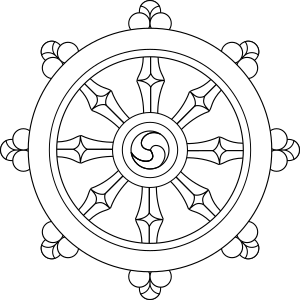- This is a personal developmental wiki, it may often be in an unstable or experimental state and the lack of meaningful content on a page is often intentional; however, you can participate. Please: 1) create an account, 2) confirm your e-mail, 3) send Deirdre and e-mail telling her who you are and why you are interested. Thanks, --Deirdre(talk • contribs)
Buddha-dharma
Buddha-dharma or Dharma vinaya
Siddhārtha Gautama or Sakyamuni (or Shakyamuni) Buddha taught:
Contents
The Four Noble Truths
- The Four Noble Truths(Sanskrit: catvāri āryasatyāni; Pali: cattāri ariyasaccāni):
- The truth of dukkha (suffering, anxiety, unsatisfactorinessTemplate:Refn) (i.e. that suffering is an ingrained part of existence)
- The truth of the origin of dukkha (i.e. that the origin of suffering is craving for sensuality, acquisition of identity, and annihilation)
- The truth of the cessation of dukkha (i.e. that suffering can be ended)
- The truth of the path leading to the cessation of dukkha (i.e. that following the Noble Eightfold Path is the means to accomplish this)
The Noble Eightfold Path

- The Noble Eightfold Path (Template:Lang-pi, Template:Lang-sa):
- right view,
- right intention,
- right speech,
- right action,
- right livelihood,
- right effort,
- right mindfulness, and
- right concentration.
Dependent Arising
Pratītyasamutpāda (Sanskrit; Pali: paticcasamuppāda), commonly translated to English as dependent origination or dependent arising this can be understood as the "principle of cause and effect" and is explained by Wikipedia thus:
- On a general level, it refers to one of the central concepts in the Buddha-dharma tradition—that all things arise in dependence upon multiple causes and conditions.
- On a specific level, the term is also used to refer to a specific application of this general principle—namely the twelve links of dependent origination.
The concept of pratītyasamutpāda (in both the general and specific meanings) is the basis for other key concepts in Buddhism, such as karma and rebirth, the arising of dukkha (suffering), and the possibility of liberation through realizing no-self (anatman). The general principle of pratītyasamutpāda (that everything is interdependent) is complementary to the concept of emptiness (sunyata). More simply it can mean the mind creates suffering as a natural product of a complex process.
However, the wikipedia:Avatamsaka Sutra as understood in Huayan school of Chinese Buddha-dharma as well as by D.T. Suzuki, who had a big influence in the west, involve all things being dependent on each other such that causes of an event are contained within effects of the event (or even within the event itself?).
Teachings of the Kalamas
The Kalama Sutta (also known as the Kālām Sutta; Template:Lang-sa; Template:Lang-myKalama thoke; Template:Lang-th, Kalama Sut, or Kesamutti Sutta; Pāli: Kesamuttisuttaṃ; Template:Lang-my Kethamotti thoke)
- Rejection of the truth of teachings without personal inquiry, such that they are both borne out by personal experience and praised by the wise
- The Four Solaces (that a moral life would be correct even if there were no Karma)
The Three Marks of Existence
The Three marks of existence within Budda-dharma are three characteristics (Pali: tilakkhaTemplate:IASTa; Sanskrit: trilakTemplate:IASTaTemplate:IASTa) shared by all sentient beings, namely:
- impermanence (anicca)
-
- (Sanskrit: anitya): That all things that come to be have an end
- suffering or unsatisfactoriness (dukkha)
-
- (Sanskrit: Template:IAST): That nothing which comes to be is ultimately satisfying
- non-self (anattā)
-
- (Pāli:anattā; (Sanskrit: anātman (Template:Lang-sa)): That nothing in the realm of experience can really be said to be "I" or "mine"
Nirvana
- Nibbāna (Sanskrit: Nirvāna): It is possible for sentient beings to realize a dimension of awareness which is totally unconstructed and peaceful, and end all suffering due to the mind's interaction with the conditioned world.